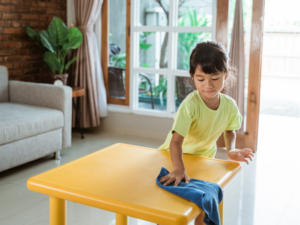We see impulse control issues all the time. Running into the middle of the street after you’ve told your child to stay nearby. Hitting the family pet after you’ve repeatedly explained how to use “gentle hands.” Grabbing a toy from another child without asking for a turn. You’ve seen it before. It’s called impulsivity. And it’s very common among toddlers below the age of three.
Impulsivity is a child’s inability to hold back on certain actions, even if it may put them in danger or they know it’s inappropriate. Impulse control, commonly referred to as self-control, can be thought of as the brain’s stop sign. Toddlers and children often have difficulty thinking before acting. Their brains can almost always convince them that their actions are a good idea.
Why Do Children Struggle with Impulse Control?
Why do young children struggle with self-control so much? First, the part of the brain that helps us slow down and control our behaviors (our frontal lobe and prefrontal cortex) takes about 25 years to develop fully! In other situations, it’s simply genetics and the child’s environment playing a role in impulsivity. Is that a reason to give up on teaching impulse control to children altogether? Absolutely not.
Why Deal with Impulse Control?
Self-control allows children to cooperate with others, cope with frustration, and resolve conflicts. Some skills facilitate self-control and can be taught in early childhood, such as emotion regulation and problem-solving skills. Both foundational skills help reduce impulsivity later in life. Some of the outcomes associated with these skills include:
- Better relationships with others
- Ability to cope with stress
- Better self-discipline
- Academic achievement
- Ability to focus on and complete tasks
- Better at shifting their attention when needed
- Better able to adapt to changes in the environment
Some children struggle with impulsivity because of differences in the way their brain develops in utero or due to complications during birth. According to the CDC, factors that may impact development include genetics, parental health, behaviors (such as smoking and drinking) during pregnancy, and/or exposures of the birthing parent or child to high levels of environmental toxins, such as lead.
What Causes Impulse Control?
For some developmental disabilities, such as fetal alcohol syndrome (FAS), caused by drinking alcohol during pregnancy, we know it can be the cause. But for most, the causes are unknown, and much research is actively examining potential causes for differences in brain development. Recent prevalence rates in the U.S. show that 17% of children aged 3 through 17 years have one or more developmental disabilities, such as Attention-Deficit/Hyperactivity Disorder (ADHD), autism spectrum disorder (ASD), cerebral palsy, hearing loss, intellectual disability (ID), learning disability, vision impairment, and other developmental delays.
How to Help Your Child
Each child is different and, depending on the differences, may require different approaches to teaching self-regulation, such as the incorporation of visual aids, structured routines, rewards, reinforcement, and/or more repetition and patience as they learn the skill. For example, you might use a “First-Then” board to help scaffold the learning of a skill such as deep breathing. At the “first” part of the board, you may use an image of a deep cartoon breathing or a picture of your child’s deep breathing. In the “then” part of the board, you may use an image of a treat or activity they like to remind them that they must breathe before getting their reward. In the future, you can use the same board when a child struggles to regulate their body and needs support.
Activities to Develop Impulse Control Skills
Below are various activities you can try at home with your little ones. The activities are categorized by age. However, you may use the younger-aged activities for older ages as well. For example, providing consequences for lack of self-control is appropriate for any age group. The goal is to tailor them to your child’s developmental level and needs.
Activities for Teaching Impulse Control at Age Two
- Provide consequences for lack of self-control: If your 2-year-old throws something in a rage, you should ask your child to pick it up. If they refuse, you will want to use a scaffolding approach to help the child through the motions of picking up the object. You can start by verbally listing the steps involved in picking up the object. If your child continues to refuse, you can try using the hand-over-hand This involves placing your hand over the child’s hand and guiding the child in action. Once the child has completed the task, remember to praise your child!
- Mindful Parenting: Mindful parents see their children as little people with their own feelings, thoughts, and intentions. In the scenario above, it is important to remember that at that moment, the toddler’s only skill for coping with anger is to throw objects. As a mindful parent, you could provide language for the child to help them label and understand their emotions. You could say, “I see you are angry because you threw your toy.” Giving your child the words to describe their feelings is the first step toward helping them manage their emotions and develop self-control. You could also model coping strategies, such as a deep breath – to verbally describe your actions and provide an example, “When I’m angry, I take a deep breath,” and show them how.
Activities for Teaching Impulse Control at Age Three and Four-Year-Olds
- Stop and Go: Use a green and red card to play a stop-and-go game. If you don’t have cards at home, you can color a paper plate on each side red and green and put the words “stop” and “go.” Use the green side to let the child engage in an activity like running or shouting and the red stop to communicate that they should stop. You can even use a yellow card to help them start slowing down.
- Freeze Dance: Spend 5 minutes with your child dancing to music and freezing when they hear the music stop. This is the perfect way to bond with your child and teach them self-control!
- Simon Says: Play a game of Simon says. When you say, “Simon says,” they must complete the following action. Remember that they cannot complete the action unless they hear the words “Simon says.” This is a great way to help them develop their listening skills and practice self-control.
Note: When possible, include other children in play and explicitly teach turn-taking to help your children learn to wait their turn and slow down.
Activities for Teaching Impulse Control at Age Five
- Change the Situation: The simplest and often most effective strategy for self-control involves changing the situation to reduce temptation. It requires very little effort and is very effective. If you notice your five-year-old bickering or fighting with their sibling, you can separate them and ask them to play alone for 10 minutes so that they can calm their bodies.
- Practice Problem-Solving: Teaching your 5-year-old problem-solving skills can help them learn that there is usually more than one way to approach a problem. It also teaches them to evaluate the solutions before springing into action. The Problem-Solving Model includes identifying a problem, developing 3-5 possible solutions, identifying the pros and cons of each solution, picking a solution, and then testing it out and re-evaluating it. Practice working through common problems children this age encounter, such as difficulty sharing with others.
Problem-Solving Model
-
- Identify the problem
- Develop 3-5 possible solutions
- Identify the pros/cons of each solution
- Pick a solution
- Test it and re-evaluate
Activities for teaching Impulse Control at any age group
- Emotion Regulation: Children are more likely to react on impulse when they are overly excited, angry, or feeling another big emotion. Teach your child specific strategies to calm their bodies that you can join them in doing, such as taking deep breaths, walking around the house to burn off energy, or playing with fidget toys. You can say, “If you feel excited, clap your hands and jump up and down on the spot,” or “If you feel angry, go into your room and squeeze your pillow hard. Come back when you’re calm.” When children experience very big emotions, sometimes they need to wait for those strong emotions to pass. Let them know it is OK to feel strong emotions. You may need to explain further that just because they felt a big emotion does not mean their reactions are OK.
Wrapping it Up
Impulsivity is common in toddlers and young children. Practicing these skills over time should help decrease impulsivity in your children. However, if you are concerned that your child’s impulsivity is above and beyond what you would expect for a child their age, please speak with their pediatrician. Underlying conditions such as ADHD or developmental delays may affect your child’s ability to manage impulsive behavior.




